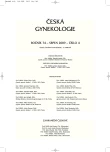Long-term review on posterior colporrhaphy with levator ani muscles plication and incorporating a Vypro II mesh
Authors:
R. El Haddad; A. Martan
; J. Mašata; K. Švabík; T. Koleška
Authors‘ workplace:
Gynekologicko-porodnická klinika VFN a 1. LF UK, Praha, přednosta prof. MUDr. A. Martan, DrSc.
Published in:
Ceska Gynekol 2009; 74(4): 282-285
Category:
Original Article
Overview
Objective:
Pelvic organ prolapse affect 50% of parous women over 50 years of age. The lifetime risk of undergoing a single operation for prolapse or incontinence by age 80 is 11.1%. Recurrence rates for classical prolapse surgery are as high as 30%. For this reason various graft materials have been proposed to improve the long-term surgical outcomes. The aim of our study was to investigate the safety and efficacy of posterior colporrhaphy incorporating Vypro II (polyglactin 910-polypropylene) mesh in the treatment of posterior vaginal wall prolapse.
Design:
Retrospective study.
Setting:
Gynaecological and Obstetric Clinic, First Medical Faculty of Charles University and General University Hospital, Prague.
Methods:
Standard posterior colporrhaphy was performed with levator ani muscles plication. Vypro II (Ethicon, Somerville, NJ, USA) is a type III macroporous mixed fibre lightweight mesh composed of 50% absorbable multifilamentous polyglactin 910 and of 50% non-absorbable multifilamentous polypropylene fibres. This operation was performed in 28 women between March 2003 and November 2005. All patients underwent before surgery, urodynamics, ultrasound and physical examination. 22 women (78.5%) had a previous hysterectomy, 16 women (57%) had previous pelvic surgery for prolapse and/or urinary incontinence. Concomitant surgeries performed included vaginal hysterectomy 7% (n=2), anterior colporrhaphy 50% (n=14), anterior colporrhaphy with Vypro II mesh 21.4% (n=6), TVT 7% (n=2), TVT O 7% (n=2), sacrospinous vaginal vault suspension 32% (n=9). The pelvic organ prolapse was staged in ICS POP-Q system. All women had stage II-IV symptomatic prolapse of the posterior compartment (11 patients 39.2% with stage II, 14 patients 50% with stage III and 3 patients 10.7% with stage IV). All patients were examined always in case of complications and were invited to follow-up 2 months after surgery and once a year. The mean follow-up was 26.2 months (range 2-58), whereas 71% of pacients had a follow up longer then 24 months.
Results:
Pacients mean age was 63.7 years (range 46-83), mean parity 2.1 (1-3) and mean BMI 30.34 kg/m2 (25-42). There were no operative or early postoperative complications like bowel erosion or rectovaginal fistula. The incidence of rectocele recurrence was 10.7 %: 1 case of stage II rectocele and 2 cases of stage III rectocele. The incidence of mesh vaginal erosion was 10.7%. Two cases were resolved by repeated excision in office and by local estrogen and local antimicrobial therapy. The third case required reoperation and mesh exstirpation.
Conclusion:
Posterior colporrhaphy with levator ani muscles plication and incorporating a Vypro II mesh was associated with a higher incidence of post-operative complications even if cure rate was quite good.
Key words:
posterior colporrhaphy, Vypro II, mesh erosion.
Sources
1. Amid, PK. Classification of biomaterials and their related complication in abdominal wall surgery. Hernia, 1997, 1, p. 15-21.
2. Bump, RC., Mattiasson, A., Bo, K., et al. The standardisation of terminology of female pelvic organ prolapse and floor dysfunction. Am J Obstet Gynecol, 1996;175, p. 10–17.
3. Dwyer, PL., O’Reilly, BA., et al. Transvaginal repair of anterior and posterior compartment prolapse with Atrium polypropylen mesh. BJOG, 2004, 111, p. 831-836.
4. Halaška, M., Voigt, R., Havel, R., et al. Sexuologische und urodynamische Nachuntersuchungen nach vaginaler Inkontinenzoperation. Gynäkol prax, 1990, 14, p. 343-347.
5. Halaška, M., Voigt, R., Martan, A. „Prague“ stitch in the prevention of the vaginal vault prolapse. Int Urogynecol J, 1996, 7, p. 170.
6. Lim, YN., Muller, R., Corstiaans, A., et al. A long-term review of posterior colporrhaphy with Vypro 2 mesh. Int Urogynecol J, 2007, 18, p. 1053-1057.
7. Martan, A. Nové vaginální operační postupy v rekonstrukční pánevní chirurgii a urogynekologii. Čes Gynek, 2006, 6, s. 455-463.
8. Martan, A., Švabík, K., Mašata, J. Incidence a prevalence komplikací po protetických urogynekologických a rekonstrukčních operacích pánevního dna a jejich řešení u žen. Čes Gynek, 2007, 6, s. 410-415.
9. Milani, R., Salvatore, S., Soligo, M., et al. Functional and anatomical outcome of anterior and posterior vaginal prolapse repair with prolene mesh. Br J Obstet Gynaecol, 2005, 112, p. 107-111.
10. Olsen, AL., Smith, VJ., Bergstrom, JO., et al. Epidemiology of surgically managed pelvic organ prolapse and urinary incontinence. Obstet Gynecol, 1997, 89, p. 501-506.
11. Prien-Larsen, JC., Hemmingsen, L. Long-term outcomes of TVT and IVS operations for treatment of female stress urinary incontinence: monofilament vs. multifilament polypropylene tape, Int Urogynecol J, 2009, published online DOI 10.1007/s00192-009-0844-7.
12. Stanton, SL. Female stress incontinence. Treatment options and indications. Urologe [A], 1991, 30, 4, p. 239-243.
13. Suback, LL., Waetjen, LE., Van den Eeden, S., et al. Cost of pelvic organ prolapse surgery in the United States. Obstet Gynecol, 2001, 98, p. 646-651.
Labels
Paediatric gynaecology Gynaecology and obstetrics Reproduction medicineArticle was published in
Czech Gynaecology

2009 Issue 4
Most read in this issue
- Vaginal combined contraception NuvaRing in the clinical practice in the Czech Republic
- Placenta adherens partim accreta
- Long-term review on posterior colporrhaphy with levator ani muscles plication and incorporating a Vypro II mesh
- Level of CA125 and hemoglobin as prognostic factors ovarian cancer
